
Among the more unlikely “marriages” arranged by human ingenuity is the one between the Chinese domesticated silk moth, Bombyx mori, and the Mediterranean sea snails of the Muricidae, or murex, family. The sea snails produce a pigment that, when brought together with silk, led to the world’s longest-lasting fashion statement.
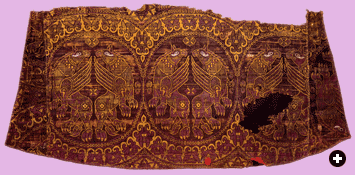 |
| SION (SWITZERLAND) / ÉGLISE DE VALÉRE / ABEGG-STIFTUNG, RIGGISBERG |
| This fragment from an 11th-century Byzantine robe shows griffins embroidered on a delicate silk woven of murex-dyed threads. It was in the eastern Roman empire of Byzantium that the symbolic power of murex purple reached its apogee. |
Written by Philippa Scott
Murex is the dye first famous as “Tyrian purple,” named for the city
of Tyre, today in Lebanon but 3000 years ago the center from which that energetic trading nation, the Phoenicians, controlled a far-flung luxury trade in murex-dyed silks. Later, the dye was known as “royal purple”
or “imperial purple,” from the
Roman and Byzantine emperors who reserved the color for members of the imperial family.
The search for stable, brilliant textile dyes is an ancient one. Early dyers experimented with plants, lichens, colored earths, stones containing metallic oxides, insects, blood, seaweeds—and shellfish. Shell mounds, pits full of shells and stretches of seashore made up of millions of crushed shells are continually being discovered, forcing archeologists and historians to reassess dates and boundaries. Archeologists working in Qatar, along the Gulf coast of the Arabian Peninsula, have recently uncovered shell middens—discard heaps—that date to the 18th century BC and are composed mostly of the Thais
savigni species of murex. Nearby were pits with hearths and dye pots more than a meter (39'') in diameter. Until this discovery, historians believed the story of murex purple dyes began around 3000 BC with the Minoan civilization of Crete, and was then advanced by the enterprising Phoenicians. Now it seems probable that the use of shellfish dyes developed as independently
in what is today Qatar as it did in the Mediterranean and the Americas. (See
“It’s a Purple World,” opposite.)
 |
| G. MASPERO, HISTORY OF EGYPT, VOL. IV (LONDON: THE GROLIER SOCIETY, 1903) |
 |
| STATE HERMITAGE MUSEUM |
| The oldest known murex-dyed textile is a fine wool tapestry woven during the fifth to fourth centuries bc in Persia. Originally a garment, it was later adapted—in a well-worn condition—as a felt-lined horse trapping, which was buried with its owner. |
In the Mediterranean there are 16 species of Muricidae. Three that are common to the eastern Mediterranean were specifically fished for dye: Murex trunculus, Murex brandaris and Thais haemastoma (also called Purpura haemastoma). The earliest, most complete written account of early dyeing techniques comes from Pliny the Elder in the first century of our era, but researchers have recently found that Pliny either misunderstood certain processes or was misinformed—or perhaps intentionally misled by craftsmen reluctant to fully reveal their techniques. For example, it might be true, as Pliny claimed, that honey was a traditional ingredient in the murex formula, or there may be a lost legend about it, or a belief in some symbolic potency of which today we know nothing. However, modern methods of chemical analysis have found honey to be of no practical use in murex dyeing.
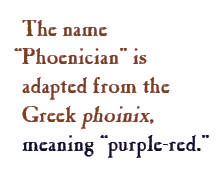
The Minoan civilization of Crete endured some two millennia, from roughly 3000 BC to 1000 BC. Excavations there have revealed houses decorated with frescoes that used murex purple as a paint. Some earthen floors have been found to contain crushed murex shells as aggregate—an example of recycling from about 1500 BC. Murex shells appeared as a design motif on pottery and on carved gemstones. From frescoes, painted figures and pottery, we know that the Minoans wove fine wool
cloth that was profusely patterned
and colored; however, we do not
know whether the designs were woven, embroidered, appliquéed or printed, for archeologists have not yet found any of the textiles themselves.
The extensive Minoan trading network operated by barter, coinage not having yet been invented, and cloth was among the most important trading elements. To the south, Egypt was a significant trading partner, and the Papyrus Anastasy, a New Kingdom document written about 1400 BC (now in the Victoria Museum in Upsala, Sweden), includes 70 formulae for dyeing wool, most of which deal with purple. There is a vivid description of a purple dyer: “His hands stink, they have the smell
of decaying fish. His eyes are overcome with exhaustion.”
From the 15th century BC or earlier, murex dyeing was also carried on along the north coast
of Syria at the port of Ugarit, at Mina al-Bayda. Here, archeologists’ finds include lots of crushed shells and part of a pot still stained with purple. Surviving Ugaritic texts describe a thriving commerce in purple wool and purple cloth. They mention wool being dyed in the yarn, an indication that craftsmen may have practiced pattern weaving. An Assyrian chemist’s text gives a formula for murex purple dye. Eastward in Mesopotamia, Babylonians dressed sacred idols in purple cloth.

Beyond the Mediterranean, there are a number of other sea snails useful for dyeing. Some 140 species flourish off the shores of North and South America. Of these, Purpura patula, Purpura persica and Purpura aperta inhabit the Gulf of Mexico, and these are still valued today in Central America, where women use them to color skeins of yarn. Sun and saltwater cause the pigment to oxidize on the fibers into an attractive but uneven purple. Unlike the Mediterranean types of murex, which must be crushed in order to obtain the tiny sac of pigment, the gland on the American shellfish is closer to the surface, and the creature can be persuaded to squirt its secretion onto the yarn. Afterward, the shellfish can be put back into the sea, given time to recover, and used again. Threads colored in this way tend to retain a fishy smell, however. The dyes in many pre-Columbian textiles and the purple paint in the Nahuatl codices have been analyzed and found to be shellfish purple.
In ancient Japan yet another type of shellfish was used. In the waters around Scandinavia and the British Isles, the Anglo-Saxons called purple dye fiscdeag (“fish dye”), and in the seventh century the Venerable Bede wrote about red and purple dyes obtained from sea snails. In Australia, although there are equivalent shellfish, no evidence has yet been found that these were ever used for textile dyeing. |
|
But it was another seafaring nation of traders, the Phoenicians, who were destined to become irrevocably linked with murex purple dye. The name “Phoenician”—and “phoenix,” the
legendary bird reborn in the flames—
is derived from the Greek phoinix, meaning “purple-red.” (Murex comes to us from Latin, derived from the Greek muax, or “purple fish.”) It was the Phoenicians who developed and promoted the Mediterranean murex market. Herodotus tells
us that Tyre, built on an island and the neighboring mainland, was founded in 2759 BC. Archeology supports this as a roughly probable date for the arrival and settlement of this Semitic people from somewhere further south. The geography of their long, narrow country, with its high mountains sloping toward the coastal plain, made the Phoenicians look naturally outward to the sea.
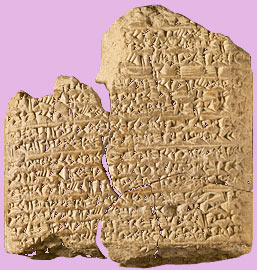 |
| BRITISH MUSEUM |
| Dye formulae of many kinds were widely known by the time this cuneiform tablet was inscribed in the seventh century bc near Babylon, now in Iraq. It describes the dyeing of wool to shades of “lapis-lazuli,” which was apparently an attempt to imitate murex. |
The sea meant trade, and by the eighth century BC, the Phoenicians were established as traders, craftsmen and daring seafarers, and Phoenician sarcophagi depict wealthy businessmen. Perhaps because good business required efficient accounting, the Phoenicians invented an alphabet which was passed on to and adapted by the Greeks—and which became the origin of our own today. Phoenician vessels traveled as far as the British Isles, where they traded for tin in Cornwall and tin, gold, silver and copper in Spain.
All around the Mediterranean there are wide stretches of beaches composed of crushed murex shells, silent witnesses to the geographical scope and longevity of the Phoenician dyeing industry.
One famous Phoenician dye-works was near Cadiz, in the south of Spain; others were in present-day Tunisia, where Carthage was a Phoenician colony. At all these sites, the shellfish were crushed, and the pigment extracted, processed, mixed and used. Gravestones of “purple merchants” (purpurarii or negotiatores artis purpurariae) often show a set of scales or hanks
of yarn, indicating that here too yarn was dyed before weaving, enabling it to be used for woven patterns and embroidery.
On the supply end, the “marriage” of silk and murex may have occurred relatively early. Strands of Chinese silk—the remains of a decorative net, perhaps—have been identified in the hair of an Egyptian mummy dating from 1000 BC, long before an established trade network is thought to
have existed—a reminder of the importance of keeping an open mind to the reassessment of historical knowledge. The East–West land and maritime routes that became known as the Silk Roads are generally considered to have been “opened up” during the time of the Han and the Roman Empires, but already during the sixth century BC, Greek vessels carried silk to the Mediterranean via trading settlements around the Black Sea. The Chinese, who kept close account of all silk production outside their borders, recorded that Syria was a silk producer by the fifth century of our era.
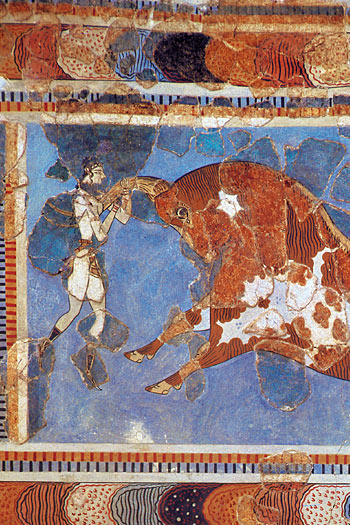 |
| ARCHAEOLOGICAL MUSEUM, HERAKLION / ART RESOURCE (DETAIL) |
| To paint this fresco of a bull-leaper, a Minoan artist of approximately 1500 bc used murex dye in his palette. |
The commercial success and enduring appeal of murex was based on solid science. Silk and wool are both protein fibers obtained from living creatures and, as such, they both have carboxyl and amino groups available to which dyestuffs can bond, unlike such plant fibers as cotton, linen, hemp, nettle and jute. Silk, as strong as steel, weight for weight, is also highly absorbent, which makes it easier to dye than any other fiber. This meant it required less dye to achieve more effect. Results ranged the palette from heavy ultramarine blues and purples to gentle lilacs, mauves and pinks, all depending on dye mixture and timing. Silk, it turned out, was more than a chemically compatible partner for murex: Both were labor-intensive in use, extremely expensive and long-lasting, and the Phoenicians justified the high prices they demanded for murex because so little pigment was obtained from the glandular secretions of each shellfish. (See “How Murex Works”)
When Alexander the Great’s troops, marching east in 324 BC, took the Achaemenid winter capital Susa (in today’s Iran), they found a vast store
of purple robes and cloth in the royal treasury. Afterward, Alexander’s generals criticized their leader for swanning around in the all-purple robes “like a Persian.” To the austerity-loving Greek mind of the time, only a show-off would don such ostentatious luxury. Not long afterward, however, possibly thanks to captive Phoenician dyers, the Greeks learned purple technology themselves. Purple dye works have been excavated in Corinth, and murex shells were depicted on certain Greek coins. Archeologists excavating the royal Macedonian graves at Vergina found the bones of Cleopatra, Philip II ’s youngest wife and Alexander the Great’s stepmother, wrapped in a breathtaking fabric of the finest purple wool, delicately woven with gold thread. A fragment of that royal shroud has recently been analyzed and proved, not surprisingly, to have been dyed with murex.
The Phoenicians continued trading until the late fourth century BC, when the gradual incorporation of their cities into the Greek empire effectively put an end to a separate Phoenician identity. However, their dyeing and textile skills continued to flourish in the Levant
and Syria.
 |
| MUSÉE BONNAT / PHOTOS12.COM (DETAIL) |
| In 1636, Flemish artist Peter Paul Rubens depicted the legendary discovery of murex by the Phoenician god Melcarth (in Greek versions of the tale, it is Hercules), who was strolling along the shore when his dog began to play with a murex snail, staining his muzzle. The legend may be a reminder that murex snails are best harvested in early spring, when Sirius (the “Dog Star”) is high. |
By the time Julius Caesar returned
to Rome from Egypt in 47 BC, his mind awash with thoughts of Cleopatra’s perfumed purple sails, the number of purple stripes or emblems on any Roman male’s outer garment was an indication of his rank, authority and prestige. This prompted imitations and became a fashion. Artists and orators donned purple. Nero, who had a habit of taking things to extremes, wore all-purple robes, and it was he who issued a decree that anyone else who did so would be executed.
In the breakaway Syrian state of Palmyra, grown rich from the Silk Roads trade, statues show its citizens elaborately coiffed and bejeweled, and the folds of their carved robes drape in silk’s inimitable manner. Murex purple has been identified in some of the Palmyran silks discovered in graves and funeral towers. When Palmyra fell to Rome in the year 273, its queen, Zenobia, was paraded through the streets of Rome in golden chains—
and we may be reasonably certain that she also wore murex-dyed silks from Palmyran looms.

At first, the mucus-like glandular secretions of all types of murex are colorless or faintly yellow. The glands of the American species are close to the surface, which means the animals can be squeezed lightly, then replaced in the water alive, but in the Mediterranean, the species must be crushed. Exposure to sunlight and air causes rapid oxidization, turning the secretions into a purple pigment. If this is immediately rubbed onto fabric (or, as in a Phoenician legend, a dog’s muzzle), it will stain. Each shellfish, however, produces very little pigment, and although this method of rubbing the pigment onto thread or fabric is used in the Americas, it was not practical for Phoenician commercial purposes. Murex produce most of their secretions in early spring, the season when Sirius, “the Dog Star,” is high in the northern hemisphere’s sky, and thus the legend of Melcarth (Hercules) and his dog may in fact be a folktale reminding people of this seasonal advantage.
A pigment is a coloring agent, but to become a dye that will attach itself permanently to fibers, it needs to be processed. Murex is chemically related to the indigo dye family (which includes woad), and all these need to be processed in dyeing vats in an alkaline solution. Usually this meant a mixture of saltwater, wood ash, fermented urine or lime-water. (The salt stops the shellfish’s flesh from rotting, just as salt-curing preserves meat). No doubt dyers had their own formulae, each with varying quantities, reduction times and so on.
Once the dye had been made, it could be used to color cloth or unwoven yarn, or it could be dried and made into a powder, which could then be stored or transported and later reconstituted. After the cloth or yarn had been dyed, its color could be brightened by rinsing in an acetic-acid bath, such as diluted vinegar.
The trickiest question is, how many sea snails were required for dyeing? Enormous numbers have always been quoted, and indeed the dyeing vats used in ancient Qatar had a capacity of more than 600 liters (160 gal).
One experiment in 2001 with woollen fleece found that good color could be obtained on one gram of wool (11/30 oz) with just three snails, though darker hues and a more uniform color could be obtained by using a more concentrated dye solution and less wool. Excellent uniformity of dyeing was obtained using three successive one-gram samples of wool, 20 medium-sized snails (total weight, with shells, about 360 grams [13 oz]) and about 200 milliliters (6¾ oz) of sodium carbonate, or washing soda, as the alkaline solution—just enough to cover all the snails. The minimum recipe to produce uniform purple color was seven snails and 70 milliliters (2⅓ oz) alkaline solution.
Based on these findings, the researchers calculated that dyeing a robe, cloak, mantle, toga or other garment that weighed only a kilogram (2.2 lb) to a deep shade would require not fewer than 10,000 snails. |
|
But it was in the eastern Roman Empire of Byzantium that the murex purple fashion reached its all-time apogee. When Emperor Constantine established his new city, Constantinople, in 330, the Byzantines embraced the symbolism of purple. Ancient Phoenicia and Syria became Byzantine territories. Syrian merchants were accorded special privileges in the imperial city, for they brought the most desirable dyestuffs and the most desirable purple-dyed
silk, some already woven and some as thread, to supply the imperial weaving ateliers. The Byzantine silk industry was strictly regulated by guilds, and silks of both purple and purple-and-gold were imperial monopolies. Many Byzantine laws regulated the sale, production and wearing of purple, and punishment for their breach was severe.
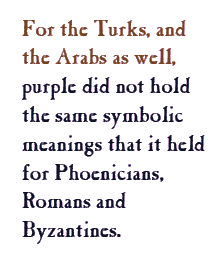
If in Rome a single stripe of murex purple had signified wealth, prestige and, at times, even aristocracy, how much more magnificent was a Byzantine subject dressed in a purple garment or—better yet—in
a purple silk garment? More prestigious still were purple silk garments woven with gold thread, in patterns of varying degrees of intricacy. And what of the Byzantine imperial children, literally and in every symbolic sense “born to the purple,” raised in the porphyra, a room with pillars and
a floor of polished purple porphyry, hung all around with perfumed purple drapes? As a finishing touch, there was also imperial footwear, crimson or scarlet, sandals or boots, for men and women alike.
Of all
the shades obtained from murex, the Byzantine favorite was a dark violet color sometimes described as “cockroach.” Exerting a strict monopoly on murex, the Byzantines colluded with the Syrian merchants to maintain and protect this
market. Foreign rulers begged for trading privileges that would include Byzantine silks, and a gift of Byzantine silk was a treasure indeed. It may be difficult for us to imagine today, accustomed as we are to the easy worldwide availability of silk, but it is no exaggeration to say that in the Byzantine economy and in Byzantine diplomacy,
the central position of their fabulous silks is loosely comparable to the role of crude oil in today’s world.
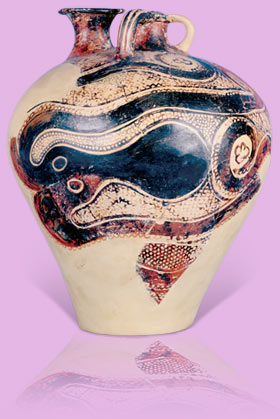 |
| ASHMOLEAN MUSEUM, OXFORD / BRIDGEMAN ART LIBRARY |
| A Minoan earthenware jar, dated between 1450 and 1400 BC, depicts an octopus and semiabstract murex trunculus shells. |
All around the Mediterranean, throughout the Roman Empire, from Phoenician times until the collapse of the Byzantine Empire and the fall of Constantinople in 1453, purple meant glamour, royalty, aristocracy, wealth and power. Authors have often
borrowed this symbolism: In 1400, Geoffrey Chaucer wrote of “the venom of Tyre” and “the bright fleeces of the land of Syria” and, quoting St. Jerome, warned, “wives that are apparelled in silk and in precious purple are not able to clothe themselves in Jesus Christ.” Shakespeare’s image of Cleopatra’s royal barge conjures romance: “Purple the sails, and so
perfumed that the winds were lovesick with them.” And Byron: “The Assyrian came down like a wolf on the fold / And his cohorts were gleaming in
purple and gold.”
Our ancestors thus understood “purple” in a broader, more symbolic sense than we do today. Many a student in recent times has puzzled over Homer’s “wine-dark sea,” in The Iliad: The sea can be dark blue, they wonder, but surely not wine-colored. As a color, however, “purple” encompassed all the shades that could be obtained from the murex family of shellfish, from ultramarine to pink. Which color resulted depended on what species’ pigment went into the dye pot, what it was or wasn’t mixed with, for how long and how many times the yarn or cloth was dyed and even the season in which the shellfish had been harvested. Faced with such a rainbow, “purple” was not so much a color as a notion, a status.
The demise of murex purple has been variously attributed to the seventh-century Arab conquest of the Levant and to overfishing, but most writers and textile historians blame the Turks. Historian Stephen Runciman, in his Fall of Constantinople, wrote that two great secrets were lost when Constantinople fell to the Ottoman Turks in 1453: the military formula for making “Greek fire,” and the dyeing techniques of Tyrian purple.
 |
| CLIVE LOVELESS, LONDON |
| In the western hemisphere, artisans tended to apply shellfish dyes in the manner of paints. This fragment of a mantle from coastal Peru is between 2000 and 2200 years old. |
But there were other factors. In 1202, the Fourth Crusade sacked and looted Constantinople, and the Byzantines and their great city never fully recovered. As always throughout history, skilled craftsmen were part of the booty taken back to Italy, and among them were textile workers whose skills and knowledge boosted
the fledgling Italian silk industry,
which suddenly, around this time, began to flourish.
It is also true that for the Turks, and the Arabs as well, purple did not carry the same symbolic freight as for the Byzantines. To Muslims, green and red were the colors of life and royalty. Ottoman superstitions held black and purple to be unlucky colors. Although purple at times conferred distinction, during times of war it was an omen of death. But still, the Ottoman Turks were always canny about their textile trade, and they had no compunction about continuing to manufacture Byzantine-style silks, complete with
figures of Jesus, for the Orthodox Church in Russia. Despite some claims that Byzantine dye works and weaving
factories were destroyed by the Turks, we know that murex dyeing continued under the Ottomans, for the dye has been identified recently in at least
one silk examined by Turkish textile historians, and the Topkap¦ holdings contain other silks that, when analyzed, may well prove to be murex.
There is also the element of alum. With the collapse of the Byzantine Empire, the Ottomans began to control the lucrative trade in this vital ingredient used for mordanting textile dyes (and also for preparing leather). Alum had always been a major Byzantine export to Europe, and to the Ottomans it promised a no less vital revenue for the sultans’ coffers. But in 1460, Italians discovered a plentiful source of alum on their mainland. The Pope immediately claimed the deposits as church property, simultaneously enriching the Church and dealing a blow to Ottoman commerce.
Then, a 1467 papal decree stated that the murex purple, previously used on cardinals’ robes, should be replaced by scarlet, a color intended to bring the cardinals onto a level equal with kings. The new “cardinal purple” was dyed with a mixture of indigo and
kermes, the “beetle dye” from which English takes its word crimson—via the Arabic qirmizi. By this color shift, said the Pope, the Ottomans would lose valuable revenue and the Church would gain it, the better to wage war against them.
Yet a further blow to the murex industry lay ahead. The European
discovery of the Americas brought cochineal, a crimson dye obtained
from the insect of the same name (Dactylopius coccus). It proved less expensive than either murex or kermes. From the 16th century, with no more need to go through the laborious processes of obtaining pigment from sea snails, Turkish dyers, as others, began mixing cochineal with indigo to obtain shades formerly obtained from shellfish. (Logwood imported from Sri Lanka also gave a deep, purplish-red color, but in 1630 a complaint is recorded from the velvet-makers of Bursa, who considered this to be an inferior dye.)
Things changed further in the 19th century when chemists discovered how to make synthetic colors. When William Henry Perkin, an 18-year-old English student and lab assistant of the German chemist Wilhelm von Hofmann, accidentally discovered the dye mauveine in 1856, he initially called it “Tyrian purple,” thinking, mistakenly, that he had rediscovered the dye of the ancients. When Queen Victoria chose mauve for her Jubilee dress in 1887, she was perhaps the first monarch ever to wear silk that had been dyed to that shade without the aid of either the venerable murex or the upstart cochineal.
Fashion being a fickle jade, the murex market, so stable and central
for millennia, had finally faded. The marriage was over. The silkworm had spurned the shellfish, first for a beetle, and finally for a chemist.
 |
London-based free-lance writer Philippa Scott is a textile historian and author of several books, including The Book of Silk (2001, Thames & Hudson). |





